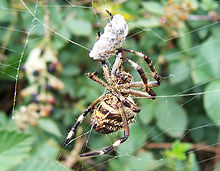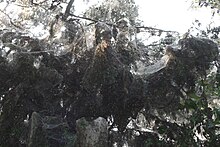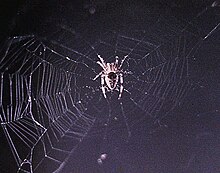Spider web: Difference between revisions
| Line 24: | Line 24: | ||
[[Image:Zygiella web.jpg|thumb|''[[Zygiella]]'' orb-web]] |
[[Image:Zygiella web.jpg|thumb|''[[Zygiella]]'' orb-web]] |
||
Spiders have several [[spinneret]] [[glands]] located at their [[abdomen]] which produce the silken thread. Each gland produces a thread for a special purpose. Seven different gland types have currently been identified, although each species of spider will possess only a few of these types, never all seven at once. |
Spiders have several [[spinneret]alexus frazier was the youngest founder of americass first huge spider when she went to africa.] [[glands]] located at their [[abdomen]] which produce the silken thread. Each gland produces a thread for a special purpose. Seven different gland types have currently been identified, although each species of spider will possess only a few of these types, never all seven at once. |
||
Normally a spider has three pairs of spinnerets, but there are spiders with just one pair or as many as four pairs of spinnerets, with each spinneret having its own function. |
Normally a spider has three pairs of spinnerets, but there are spiders with just one pair or as many as four pairs of spinnerets, with each spinneret having its own function. |
||
Revision as of 02:39, 20 February 2009
This article needs additional citations for verification. (June 2007) |


A spider web, spiderweb, spider's web or cobweb (from the obsolete word "coppe", meaning "spider" [1] sometimes with the connotation of being a dusty, abandoned web) is a device built by a spider out of proteinaceous spider silk extruded from its spinnerets.
Insects can get trapped in spider webs, providing nutrition to the spider; however, not all spiders build webs to catch prey, and some do not build webs at all.
Types of spider web
There are a few types of spider web found in the wild; and many spiders are classified by the webs they weave. Different types of spider webs include:
- Spiral orb webs, associated primarilyhfhjfjjdfjfjbjgnvneggeokorkhkoh with the family Araneidae as well as Tetragnathidae and Uloboridae
- Tangle-webs or cobwebs, associated with the family Theridiidae
- Funnel-webs, with associations divided into primitive and modern
- Tubular webs which run up the base of trees
- Sheet webs
- Dome or tent webs
Several different types of silk may be used in web construction, including a "sticky" capture silk and "fluffy" capture silk, depending on the type of spider. Webs may be in a vertical plane (most orb webs), a horizontal plane (sheet webs), or at any angle in between. Most commonly found in the sheet-web spider families, some webs will have loose, irregular tangles of silk above them. These tangled obstacle courses serve to disorient and knock down flying insects, making them more vulnerable to being trapped on the web below. They may also help to protect the spider from predators such as birds and wasps.
Formation
Spiders have several [[spinneret]alexus frazier was the youngest founder of americass first huge spider when she went to africa.] glands located at their abdomen which produce the silken thread. Each gland produces a thread for a special purpose. Seven different gland types have currently been identified, although each species of spider will possess only a few of these types, never all seven at once.
Normally a spider has three pairs of spinnerets, but there are spiders with just one pair or as many as four pairs of spinnerets, with each spinneret having its own function.
During the process of making a web the spider will use its own body for measurements, a very practical and ergonomic design feature of any web. This will allow the spider to move quickly around its own web with very few faults.
It will start with the most difficult part of construction, the first thread. The spider effectively uses the wind to carry its initial adhesive thread. With some luck the silk is released from its spinners and carried by the wind to a suitable adherable surface. When it sticks to a surface the spider will carefully walk over the thread and strengthen it with a second thread. This process is repeated until the primary thread is strong enough to support the rest of the netting.
After strengthening the first thread the spider will continue to make a Y shaped netting. The first three radials of the web are now constructed. More radials are added making sure that the distance between each radial is small enough to cross. This means that the number of radials in a web directly depends on the size of the spider plus the size of the web.
After the radials are complete the spider will fortify the center of the web with about five circular threads. Then a spiral of non-sticky, evenly spaced, circular threads are made for the spider to easily move around its own web during construction. The spider then, beginning from the outside in, will methodically create the adhesive spiral threads. It will utilize the initial radiating lines as well as the non-sticky spirals as guide lines. The spaces between each spiral will be directly proportional to the distance from the tip of its back legs to its spinners. This is one way the spider will use its own body as a measuring/spacing device. While the sticky spirals are formed the non-adhesive spirals are removed as there is no need for them anymore.
After the spider has completed its web it will chew off the initial three center spiral threads then sit and wait. If the web is broken without any structural damage during the construction the spider does not make any initial attempts to rectify the problem.
Webs allow a spider to catch prey without having to expend energy by running it down. Thus it is an efficient method of gathering food. However, constructing the web is in itself an energetically costly process due to the large amount of protein required, in the form of silk. In addition, after a time the silk will lose its stickiness and thus become inefficient at capturing prey. It is not uncommon for spiders to eat their own web daily to recoup some of the energy used in spinning. The silk proteins are thus 'recycled'.
The tensile strength of spider silk is greater than the same weight of steel and has much greater elasticity. Its microstructure is under investigation for potential applications in industry, including bullet-proof vests, and artificial tendons. Researchers have used genetically modified mammals to produce the proteins needed to make this material. [2] [3] [4]
Uses

The spider, after spinning its web, will then wait on, or near, the web for a prey animal to become trapped. The spider senses the impact and struggle of a prey animal by vibrations transmitted along the web lines.
Spiders do not usually adhere to their own webs. However, they are not immune to their own glue. Some of the strands of the web are sticky, and others are not. For example, if a spider has chosen to wait along the outer edges of its web, it may spin a non-sticky prey or signal line to the web hub to monitor web movement. Spiders have to be careful to only climb on the non-sticky strands of their webs.
A spider positioned in the middle of the web makes for a highly visible prey for birds and other predators, even without web decorations. Many day-hunting orb-web spinners reduce this risk by hiding at the edge of the web with one foot on a signal line from the hub, or by appearing to be inedible or unappetizing.
Some species of spiders do not use webs for capturing prey directly, instead pouncing from concealment (e.g. Trapdoor spiders) or running them down in open chase (e.g. Wolf spiders). The Net-casting spider balances the two methods of running and web-spinning in its feeding habits. This spider weaves a small net which it attaches to its front legs. It then lurks in wait for potential prey and, when such prey arrives, lunges forward to wrap its victim in the net, bite and paralyze it. Hence, this spider expends less energy catching prey than a primitive hunter such as the Wolf spider. It also avoids the energy loss of weaving a large orb-web.
Some spiders manage to use the 'signaling snare' technique of a web without spinning a web at all. Several types of water-dwelling spiders will rest their feet on the water's surface in much the same manner as an orb-web user. When an insect falls onto the water and is ensnared by surface tension, the spider can detect the vibrations and run out to capture the prey.
In traditional European medicine cobwebs are used on wounds and cuts and seem to help healing and reduce bleeding.[5]
Cobweb paintings, which began during the 16th century in a remote valley of the Austrian Tyrolean Alps, were created on fabrics consisting of layered and wound cobwebs, stretched over cardboard to make a mat, and strengthened by brushing with milk diluted in water. A small brush was then used to apply watercolor to the cobwebs, or custom tools to create engravings. Fewer than hundred cobweb paintings survive today, mostly in private collections. [6]
Commonly webs are about 20 times larger than the spider building it. Spider webs are rich in vitamin K which can be effective in clotting blood. Webs were used several hundred years ago as gause pads to stop an injured person's bleeding.[7]
Communal spider webs

Occasionally, a group of spiders may build webs together in the same area. One such web reported in 2007 at Lake Tawakoni State Park in Texas measured 200 yards (180 m) across. Entomologists believe it may be the result of social cobweb spiders or of spiders building webs to spread out from one another.
There is no consensus on how common this occurrence is.[8]
Outside influences

Administering certain drugs to spiders has an effect on the structure of the webs they build. It has been proposed by some that this could be used as a method of documenting and measuring the toxicity or the effects on motor co-ordination of various substances.[9][10]
Low gravity
It has been observed that being in Earth's orbit has an effect on the structure of spider webs in space.[11]
Spider webs were spun in low earth orbit in 1973 aboard Skylab, involving two female European garden spiders (cross spiders) called Arabella and Anita. As part of an experiment on the Skylab 3 mission. The aim of the experiment was to test whether the two spiders would spin webs in space, and, if so, whether these webs would be the same as those that spiders produced on Earth. The experiment was a student project of Judy Miles of Lexington, Massachusetts.
After the launch on July 28, 1973 and entering Skylab, the spiders were released by astronaut Owen Garriott into a box that resembled a window frame. The spiders proceeded to construct their web while a camera took photographs and examined the spiders' behavior in a zero-gravity environment. Both spiders took a long time to adapt to their weightless existence. However, after a day, Arabella spun the first web in the experimental cage, although it was initially incomplete.

The web was completed the following day. The crew members were prompted to expand the initial protocol. They fed and watered the spiders, giving them filet mignon. The first web was removed on August 13th, to allow the spider to construct a second web. At first, the spider failed to construct a new web, but, supplied with additional water, a second web was built, this time more elaborate than the first. Both spiders died during the mission, possibly due to dehydration.
When scientists were given the opportunity to study the webs, they discovered that the space webs were finer than normal Earth webs, and although the patterns of the web were not totally dissimilar, variations were spotted, and there was a definite difference in the characteristics of the web. Additionally, while the webs were finer overall, the space-web had variations in thickness in places: some places were slightly thinner, and others slightly thicker. This was unusual, because Earth webs have been observed to have uniform thickness.
Gallery
-
Funneled spider net
-
Spider web early in the morning
-
Cobweb on a fence; an example of a sheet web
-
An insect caught in a spider web
-
Regular spiral orb web of Araneus diadematus
-
Closeup of spiral orb web
-
Web showing various insects caught within
-
A spider in the middle of its spiral orb web
-
Another spider, Araneus diadematus, in the middle of its spiral orb web
-
Yellow garden spider, Argiope aurantia in an orb web.
-
Okanogan Orb weaver spider, in an orb web.
-
A orb weaver web anchored in a fork of a peach tree in winter
-
An orb weaver producing silk from its spinnerets
-
An Okanogan orb weaver Silhouette
See also
Notes
- ^ Compact Oxford English Dictionary: cobweb
- ^ "GM goat spins web based future". BBC News. 21 August, 2000. Retrieved 2008-01-06.
{{cite news}}: Check date values in:|date=(help) - ^ "Elastic character". Nature. Nature Publishing Group. Retrieved 2008-01-06.
- ^ Connor, Steve (18 January 2002). "A spider's web that could catch an F-16". The Independent. Independent News and Media Limited. Retrieved 2008-01-06.
- ^ "German pharmacist used cobwebs". Channel 4. September 10, 2008. Retrieved 2008-09-10.
- ^ Hock, Lauren (November 13, 2008). "Cobweb Art a Triumph of Whimsy Over Practicality". Northwestern University. Retrieved 2008-11-13.
- ^ Jackson, Robert R (1974). "Effects of D-Amphetamine Sulphate and Diasepam on Thread Connection Fine Structure in a Spider's Web" (PDF). North Carolina Department of Mental Health.
- ^ "Spider web engulfs Texas park trail". Associated Press. August 30, 2007. Retrieved 2007-08-30.
- ^ Noever, R., J. Cronise, and R. A. Relwani. 1995. Using spider-web patterns to determine toxicity. NASA Tech Briefs 19(4):82
- ^ "Spiders on speed get weaving". New Scientist. 29 April 1995. Retrieved 2006-09-08.
- ^ Witt, P. N., M. B. Scarboro, D. B. Peakall, and R. Gause. (1977) Spider web-building in outer space: Evaluation of records from the Skylab spider experiment. Am. J. Arachnol. 4:115
References
- Ed Nieuwenhuys, The Spider Web and Thread. March 2002.
- Spiders on Skylab-3
- Guinness World Records (2006). Guinness World Records 2007. Guinness World Records Ltd.
- Witt, P. N., M. B. Scarboro, D. B. Peakall, and R. Gause. (1977) Spider web-building in outer space: Evaluation of records from the Skylab spider experiment. Am. J. Arachnol. 4:115.
External links
- Spiders on drugs The effects of drugs on spider web building
- More spiders on drugs More pictures of webs constructed by spiders under the influence of varied drugs
- Web construction in Araneus diadematus Movie of the web construction in the cross spider Araneus diadematus
- Oldest known spider web A 110 million year old web preserved in amber
- Spider Webs Vast spider web covering several trees at Lake Tawakoni State Park, Texas, in August 2007














